I'm doing a histogram with broken x axis for the first time, but I'm having these problems:
- I can't get the bars of both subplots and the xx axis range to be the same width. The right subplot appears to have a larger scale.
- I can't put the label of the xx axis simultaneously for the two subplots. I would like to have only one centered label.
- Some numbers of both subplots are superimposed and there are small horizontal lines in the region where the two subplots join (I cannot remove these small lines)
- In one of the subplots the xx axis appears with commas and in the other with dots. I wish it were all commas.
- I can't adjust a log-normal distribution and calculate the mean and standard deviation for that distribution.
I would like to understand how to make this graph because afterwards I have other similar graphs to make and could practice, but now at the beginning I am a little lost and I really needed your help. How could you solve the previous problems and adjust a log-normal distribution by determining the mean and standard deviation?
Python code (Jupyter notebook - Anaconda)
#amostra 17B (menor intervalo)
import pandas as pd
import matplotlib.pyplot as plt
import numpy as np
from scipy.stats import norm
import matplotlib.ticker as tkr
import scipy, pylab
import locale
locale.setlocale(locale.LC_NUMERIC, "de_DE")
plt.rcParams['axes.formatter.use_locale'] = True
frequencia_relativa=[0.000, 0.000, 0.038, 0.097, 0.091, 0.118, 0.070, 0.124, 0.097, 0.059, 0.059, 0.048, 0.054, 0.043,
0.032, 0.005, 0.027, 0.016, 0.005, 0.000, 0.005, 0.000, 0.005, 0.000, 0.000, 0.000, 0.000, 0.000,
0.000, 0.000, 0.000, 0.000, 0.000, 0.000, 0.000, 0.000, 0.000, 0.000, 0.000, 0.000, 0.000, 0.000,
0.000, 0.000, 0.000, 0.000, 0.000, 0.000, 0.000, 0.000, 0.000, 0.000, 0.000, 0.000, 0.000, 0.000,
0.000, 0.000, 0.000, 0.000, 0.000, 0.000, 0.000, 0.000, 0.000, 0.000, 0.000, 0.000, 0.000, 0.000,
0.000, 0.000, 0.000, 0.000, 0.000, 0.000, 0.000, 0.005, 0.000, 0.000]
x=[0.10, 0.20, 0.30, 0.40, 0.50, 0.60, 0.70, 0.80, 0.90, 1.00, 1.10, 1.20, 1.30, 1.40,
1.50, 1.60, 1.70, 1.80, 1.90, 2.00, 2.10, 2.20, 2.30, 2.40, 2.50, 2.60, 2.70, 2.80,
2.90, 3.00, 3.10, 3.20, 3.30, 3.40, 3.50, 3.60, 3.70, 3.80, 3.90, 4.00, 4.10, 4.20,
4.30, 4.40, 4.50, 4.60, 4.70, 4.80, 4.90, 5.00, 5.10, 5.20, 5.30, 5.40, 5.50, 5.60,
5.70, 5.80, 5.90, 6.00, 6.10, 6.20, 6.30, 6.40, 6.50, 6.60, 6.70, 6.80, 6.90, 7.00,
7.10, 7.20, 7.30, 7.40, 7.50, 7.60, 7.70, 7.80, 7.90, 8.00]
plt.rcParams["figure.figsize"] = [20,8]
ax.yaxis.tick_left()
ax.tick_params(labeltop='off') # don't put tick labels at the top
ax2.yaxis.tick_right()
#fig, ax =plt.subplots()
f,(ax,ax2) = plt.subplots(1,2,sharey=True, facecolor='w')
ax.bar(x, height=frequencia_relativa, alpha=0.5, width=0.1, align='edge', edgecolor='black')
ax2.bar(x, height=frequencia_relativa, alpha=0.5, width=0.1, align='edge', edgecolor='black')
ax.tick_params(axis = 'both', which = 'major', labelsize = 18)
ax.tick_params(axis = 'both', which = 'minor', labelsize = 18)
ax2.tick_params(axis = 'both', which = 'major', labelsize = 18)
ax2.tick_params(axis = 'both', which = 'minor', labelsize = 18)
ax2.xaxis.set_ticks(np.arange(7.0, 8.5, 0.5))
ax2.xaxis.set_major_formatter(tkr.FormatStrFormatter('%0.1f'))
plt.subplots_adjust(wspace=0.04)
ax.set_xlim(0,3.0)
ax2.set_xlim(7.0,8.0)
# hide the spines between ax and ax2
ax.spines['right'].set_visible(False)
ax2.spines['left'].set_visible(False)
# This looks pretty good, and was fairly painless, but you can get that
# cut-out diagonal lines look with just a bit more work. The important
# thing to know here is that in axes coordinates, which are always
# between 0-1, spine endpoints are at these locations (0,0), (0,1),
# (1,0), and (1,1). Thus, we just need to put the diagonals in the
# appropriate corners of each of our axes, and so long as we use the
# right transform and disable clipping.
d = .015 # how big to make the diagonal lines in axes coordinates
# arguments to pass plot, just so we don't keep repeating them
kwargs = dict(transform=ax.transAxes, color='k', clip_on=False)
ax.plot((1-d,1+d), (-d,+d), **kwargs)
ax.plot((1-d,1+d),(1-d,1+d), **kwargs)
kwargs.update(transform=ax2.transAxes) # switch to the bottom axes
ax2.plot((-d,+d), (1-d,1+d), **kwargs)
ax2.plot((-d,+d), (-d,+d), **kwargs)
ax.set_xlabel('Tamanho lateral do triângulo ($\mu m$)', fontsize=22)
ax.set_ylabel('Frequência relativa', fontsize=22)
#x_axis = np.arange(0, 29, 0.001)
#ax.plot(x_axis, norm.pdf(x_axis,2.232,1.888), linewidth=3)
plt.show()
plt.savefig('output.png', dpi=500, bbox_inches='tight')
Graph obtained by code:
Graphic similar to what I would like to get (but I wish mine had a broken axis):
Updated code and plot:
import numpy as np
from scipy.stats import lognorm
import matplotlib.ticker as tkr
import scipy, pylab
import locale
import matplotlib.gridspec as gridspec
from scipy.stats import lognorm
locale.setlocale(locale.LC_NUMERIC, "de_DE")
plt.rcParams['axes.formatter.use_locale'] = True
frequencia_relativa=[0.000, 0.000, 0.038, 0.097, 0.091, 0.118, 0.070, 0.124, 0.097, 0.059, 0.059, 0.048, 0.054, 0.043,
0.032, 0.005, 0.027, 0.016, 0.005, 0.000, 0.005, 0.000, 0.005, 0.000, 0.000, 0.000, 0.000, 0.000,
0.000, 0.000, 0.000, 0.000, 0.000, 0.000, 0.000, 0.000, 0.000, 0.000, 0.000, 0.000, 0.000, 0.000,
0.000, 0.000, 0.000, 0.000, 0.000, 0.000, 0.000, 0.000, 0.000, 0.000, 0.000, 0.000, 0.000, 0.000,
0.000, 0.000, 0.000, 0.000, 0.000, 0.000, 0.000, 0.000, 0.000, 0.000, 0.000, 0.000, 0.000, 0.000,
0.000, 0.000, 0.000, 0.000, 0.000, 0.000, 0.000, 0.005, 0.000, 0.000]
x=[0.10, 0.20, 0.30, 0.40, 0.50, 0.60, 0.70, 0.80, 0.90, 1.00, 1.10, 1.20, 1.30, 1.40,
1.50, 1.60, 1.70, 1.80, 1.90, 2.00, 2.10, 2.20, 2.30, 2.40, 2.50, 2.60, 2.70, 2.80,
2.90, 3.00, 3.10, 3.20, 3.30, 3.40, 3.50, 3.60, 3.70, 3.80, 3.90, 4.00, 4.10, 4.20,
4.30, 4.40, 4.50, 4.60, 4.70, 4.80, 4.90, 5.00, 5.10, 5.20, 5.30, 5.40, 5.50, 5.60,
5.70, 5.80, 5.90, 6.00, 6.10, 6.20, 6.30, 6.40, 6.50, 6.60, 6.70, 6.80, 6.90, 7.00,
7.10, 7.20, 7.30, 7.40, 7.50, 7.60, 7.70, 7.80, 7.90, 8.00]
plt.rcParams["figure.figsize"] = [20,8]
f, (ax,ax2) = plt.subplots(1,2, sharex=True, sharey=True, facecolor='w')
axes = f.add_subplot(111, frameon=False)
ax.plot(x, lognorm.pdf(x,0.903,0.713), linewidth=3)
ax.spines['top'].set_color('none')
ax2.spines['top'].set_color('none')
gs = gridspec.GridSpec(1,2,width_ratios=[3,1])
ax = plt.subplot(gs[0])
ax2 = plt.subplot(gs[1])
ax.yaxis.tick_left()
ax.tick_params(labeltop='off') # don't put tick labels at the top
ax2.yaxis.tick_right()
ax.bar(x, height=frequencia_relativa, alpha=0.5, width=0.1, align='edge', edgecolor='black')
ax2.bar(x, height=frequencia_relativa, alpha=0.5, width=0.1, align='edge', edgecolor='black')
ax.tick_params(axis = 'both', which = 'major', labelsize = 18)
ax.tick_params(axis = 'both', which = 'minor', labelsize = 18)
ax2.tick_params(axis = 'both', which = 'major', labelsize = 18)
ax2.tick_params(axis = 'both', which = 'minor', labelsize = 18)
ax2.xaxis.set_ticks(np.arange(7.0, 8.5, 0.5))
ax2.xaxis.set_major_formatter(tkr.FormatStrFormatter('%0.1f'))
plt.subplots_adjust(wspace=0.04)
ax.set_xlim(0,3.0)
ax2.set_xlim(7.0,8.0)
def func(x, pos): # formatter function takes tick label and tick position
s = str(x)
ind = s.index('.')
return s[:ind] + ',' + s[ind+1:] # change dot to comma
x_format = tkr.FuncFormatter(func)
ax.xaxis.set_major_formatter(x_format)
ax2.xaxis.set_major_formatter(x_format)
# hide the spines between ax and ax2
ax.spines['right'].set_visible(False)
ax2.spines['left'].set_visible(False)
# This looks pretty good, and was fairly painless, but you can get that
# cut-out diagonal lines look with just a bit more work. The important
# thing to know here is that in axes coordinates, which are always
# between 0-1, spine endpoints are at these locations (0,0), (0,1),
# (1,0), and (1,1). Thus, we just need to put the diagonals in the
# appropriate corners of each of our axes, and so long as we use the
# right transform and disable clipping.
d = .015 # how big to make the diagonal lines in axes coordinates
# arguments to pass plot, just so we don't keep repeating them
kwargs = dict(transform=ax.transAxes, color='k', clip_on=False)
ax.plot((1-d/3,1+d/3), (-d,+d), **kwargs)
ax.plot((1-d/3,1+d/3),(1-d,1+d), **kwargs)
kwargs.update(transform=ax2.transAxes) # switch to the bottom axes
ax2.plot((-d,+d), (1-d,1+d), **kwargs)
ax2.plot((-d,+d), (-d,+d), **kwargs)
ax2.tick_params(labelright=False)
ax.tick_params(labeltop=False)
f.text(0.5, -0.04, 'Tamanho lateral do triângulo ($\mu m$)', ha='center', fontsize=22)
f.text(-0.02, 0.5, 'Frequência relativa', va='center', rotation='vertical', fontsize=22)
#ax.set_xlabel('Tamanho lateral do triângulo ($\mu m$)', fontsize=22)
#ax.set_ylabel('Frequência relativa', fontsize=22)
#x_axis = np.arange(0, 29, 0.001)
#ax.plot(x_axis, norm.pdf(x_axis,2.232,1.888), linewidth=3)
f.tight_layout()
plt.show()
#plt.savefig('output.png', dpi=500, bbox_inches='tight')


